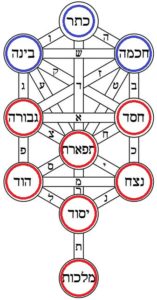How did Christianity emerge, and why did it split from Judaism to become a religion of its own? In this class we explore the true origins of Christianity, and explain the Jewish position on Jesus. Also discussed is the purpose of Christianity in world history, and some rabbinic perspectives on the religion.
Tag Archives: Ramban
The Great Disputation: Mochin vs. Trinity
This week’s parasha concludes the Ten Plagues of Egypt by describing the final three plagues, as alluded to in the name of the parasha, Bo (בא), which has a numerical value of three. One would think that the parashas would be divided in such a way that all the plagues appear in one portion. Yet, we see the first seven in one, and the final three in another. The mystical reason for this is to mirror the Sefirot, which are divided into the seven lower middot, and the three higher mochin, “mental” or “intellectual” faculties.

The Sefirot of mochin above (in blue) and the Sefirot of the middot below (in red) on the mystical “Tree of Life”.
The mochin are the three Sefirot of Keter (or Ratzon, God’s “Will”); Chokhmah, “Wisdom”; and Binah, “Understanding”. They are on a higher level than the lower seven Sefirot. In fact, in this physical world we find most things mirror the seven, including the seven discernible colours of the rainbow, the seven notes of the musical scale, the seven visible “luminaries” in the sky, and the seven days of the week. The mochin, meanwhile, represent the upper worlds, and correspond to more ethereal things like the three primordial elements of Creation (air, water, and fire, as per Sefer Yetzirah) and the three realms of space, time, and soul (in mystical texts referred to by the acronym ‘ashan, עשן, standing for olam, shanah, nefesh). (For a detailed explanation of this, see here.)
Recall that the Sefirot represent the ten major aspects of God, and are primarily meant to help us relate to, and understand, the Infinite One. As such, the mochin represent the highest aspects of God. That there are specifically three of them is significant. The number three is central to Judaism, and God has a particular affinity for this number, as the Talmud (Shabbat 88a) tells us:
Blessed is the All-Merciful One, Who gave the three-fold Torah [ie. the Tanakh, composed of Torah, Nevi’im, and Ketuvim] to the three-fold nation [Kohen, Levi, Israel] by means of a third-born [Moses] on the third day, in the third month [Sivan].
While this teaching is well-known, what isn’t so well known is in whose name it is brought down. The Talmud introduces it as a teaching “of that Galilean”. Who is this anonymous Galilean? Why does the Talmud use a seemingly-derogatory term for him, avoiding his name? Continue reading
Do Men Have More Mitzvot than Women?
This week’s parasha, Tazria, begins by describing the rituals that a mother must perform upon giving birth to a new child. If the child is male, the mother is considered “impure” for seven days following her delivery, and then spends an additional 33 days in purification. For a female child, the durations are doubled, with the mother “impure” for 14 days, and purifying for another 66 days. Why is the duration of purification for a female doubly longer than a male?
The apocryphal Book of Jubilees (3:8) suggests an interesting idea: Adam was made on the Sixth Day of Creation but, apparently, Eve wasn’t made until a whole week after. This is why a mother of a male child is impure for a week, but a mother of a female child for two weeks! Jubilees also holds that Adam was only brought into Eden forty days after being created, while Eve was brought in after eighty days. This is why a mother of a male child needs a total of forty days to purify, and a mother of a female child needs eighty days. Of course, Rabbinic tradition rejects the Book of Jubilees, and it is accepted that Adam and Eve were both created on the Sixth Day, and were in Eden from the beginning.
Commenting on this week’s parasha, the Zohar (III, 43b) states that it takes a soul 33 days to settle in the body. This is primarily referring to the new soul that enters a newborn baby, as it takes time for the ethereal soul to get used to its descent into a physical world. The Zohar doesn’t add too much more on this, but we might assume that, based on the words of the Torah, it takes a male soul 33 days to settle, and a female soul 66 days to settle. At the same time, the Zohar may be referring to the soul of the mother, too, as she is the one that spends 33 or 66 days in purification. As we’ve explained in the past, the severing of the mother’s direct connection to her child distresses her soul for 33 or 66 days following childbirth.
Whatever the case, the implication is that a female soul is somehow greater than a male soul. It has more spiritual power, taking longer to settle. The notion that female souls are greater is found throughout Jewish texts, especially mystical ones. Sefer HaBahir, one of the most ancient Kabbalistic texts, states that the female soul is the most beautiful of all, and an aspect of the Shekhinah, the Divine Presence (chs. 173-175). It explicitly makes clear that life on Earth would be impossible without the life-giving mother, who in this regard is much closer to God.
On that note, it has been said that God created the world sequentially from simple to complex, starting with the basic elements: light, air, water, earth; progressing to plants, then simple animals, then mammals, then man, and finally woman. The woman is the last of God’s creation, and therefore the most intricate and the most refined. It may be because of this that the Arizal taught that while male souls typically reincarnate to rectify themselves, female souls rarely if ever reincarnate at all (Sha’ar HaGilgulim, ch. 9).
It is important to mention here that we are speaking of female souls, not necessary to all women. The Arizal (as well as the Zohar cited above) speak of the possibility of female souls in male bodies, or male souls in female bodies. And it should also be mentioned that this does not necessarily affect the body’s sexuality. A “female” soul in a male body can still very much be a heterosexual male, and vice versa. (For more on this, see Rav Yitzchak Ginsburgh’s lecture here on the female soul of the forefather Isaac, as well as the prophets Samuel, Jonah, and Habakkuk.)
There are a number of consequences to the greater souls of females. For one, it gives them binah yeterah, an “extra understanding” sometimes referred to as “women’s intuition” (Niddah 45b). This is one reason why the women of the Exodus generation, for example, did not participate in the sin of the Golden Calf, nor the sin of the Spies. In fact, the Kli Yakar (Rabbi Shlomo Ephraim Luntschitz, 1550-1619, on Numbers 13:2) states that, had Moses sent female spies, there would have been no problem at all!
On the other hand, a more elevated soul and an extra depth of understanding means a greater sensitivity to the world, which makes women generally less prone to violence and drug abuse, but significantly more prone to depression and anxiety. The greater female soul has the amazing potential to bring life, yet simultaneously (to balance the equation) the potential for severe destruction, “more bitter than death”, to borrow from King Solomon in Kohelet 7:26. This is symbolically reflected in the menstrual cycle, where a lack of conception of life necessarily results in the shedding of blood, a “minor death” that is then rectified in the living waters of the mikveh.
Finally, a greater soul means that women require slightly less mitzvot than men. After all, the “mitzvot were given only in order that human beings might be purified by them… their purpose is to refine…” (Beresheet Rabbah 44:1) A more refined female soul does not need the same mitzvot that a male soul does. Unfortunately, this has sometimes been a point of contention in modern times. Yet, upon closer examination, we see that the differences in mitzvot between men and women are actually minimal and, contrary to the general belief, there is a perfect balance between those mitzvot done exclusively by men and those done exclusively by women.
“Time-Bound” Mitzvot?
The general rule is that, at least in principle, women are exempt from any mitzvah that can only be done at a particular time. This includes mitzvot like prayer, tefillin, and tzitzit. However, in practical terms we see that this “rule” isn’t really a thing, and there are many time-bound mitzvot that women are obligated in. For example,
The above is an excerpt from Garments of Light, Volume Two. To continue reading, get the book here!


